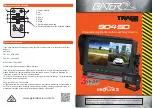
Chapter 1: Introduction
1-8
Advisor
®
Service Manual
Impedance Respiration Warnings, Cautions, and notes
WARnInG! This monitor is not for apnea detection. The monitor has not been tested or validated for use
in apnea detection.
WARnInG! Electrodes of dissimilar metals should not be used.
WARnInG! The monitor may not detect all episodes of inadequate breathing.
CAUTIon! Ensure conductive parts, including electrodes of the patient cable, do not come into contact
with any conductive surfaces or earth parts.
CAUTIon! The respiration parameter is disabled when the monitor is in the neonate operating mode.
noTE! Follow institutional standards when applying ECG electrodes.
noTE! The ECG/Respiration cable uses a standard AAMI three-lead or five-lead ECG/Respiration
connector. Use only standard AAMI three-lead or five-lead ECG wires.
noTE! The ECG/Respiration patient circuit is electrically isolated.
noTE! The monitor is protected against damage from defibrillator, diathermy, and electrocautery
discharge.
oximetry Warnings, Cautions, and notes
WARnInG! Prolonged use or the patient’s condition may require changing the sensor site periodically.
Change the sensor site and check skin integrity, circulatory status, and correct alignment at
least every 4 hours.
WARnInG! When attaching sensors with Microfoam
®
tape, do not stretch the tape or attach the tape too
tightly. Tape applied too tightly may cause inaccurate readings and blisters on the patient’s
skin (lack of skin respiration, not heat, causes the blisters).
WARnInG! Using a damaged sensor may cause inaccurate readings, possibly resulting in patient injury
or death. Inspect each sensor. If a sensor appears damaged, do not use it. Use another sensor
or contact your authorized repair center for help.
WARnInG! Using a damaged patient cable may cause inaccurate readings, possibly resulting in patient
injury or death. Inspect the patient cable. If the patient cable appears damaged, do not use it.
Contact your authorized repair center for help.
WARnInG! If any of the integrity checks fail, do not attempt to monitor the patient. Use another sensor
or patient cable, or contact the equipment dealer for help if necessary.
WARnInG! Use only Spo
2
sensors supplied with, or specifically intended for use with, this device.
WARnInG! Tissue damage may result from overexposure to sensor light during photodynamic therapy
with agents such as verteporphin, porfimer sodium and meta-tetrahydroxyphenylchlorin
(mTHPC). Change the sensor site at least every hour and observe for signs of tissue damage.
More frequent sensor site changes or inspections may be indicated depending upon the
photodynamic agent used, agent dose, skin condition, total exposure time or other factors.
Use multiple sensor sites.
Summary of Contents for Advisor
Page 2: ......
Page 6: ...Table of Contents iv Advisor Service Manual This page is intentionally left blank ...
Page 8: ...Revision History vi Advisor Service Manual This page is intentionally left blank ...
Page 43: ...Chapter 4 Diagrams Advisor Service Manual 4 1 Chapter 4 Diagrams ...
Page 44: ...Chapter 4 Diagrams 4 2 Advisor Service Manual ...
Page 45: ...Chapter 4 Diagrams Advisor Service Manual 4 3 ...
Page 46: ...Chapter 4 Diagrams 4 4 Advisor Service Manual ...
Page 47: ...Chapter 4 Diagrams Advisor Service Manual 4 5 ...
Page 48: ...Chapter 4 Diagrams 4 6 Advisor Service Manual ...
Page 49: ...Chapter 4 Diagrams Advisor Service Manual 4 7 ...
Page 50: ...Chapter 4 Diagrams 4 8 Advisor Service Manual ...
Page 56: ...Appendix App 2 Advisor Service Manual This page is intentionally left blank ...
Page 57: ......
















































